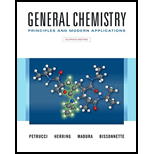
(a)
Interpretation:
For the given reaction, the value of
Concept introduction:
The Gibb’s equation of
Here,
For 298 K, the value of
(b)
Interpretation:
For the given reaction, the value of
Concept introduction:
The Gibb’s equation of thermodynamic purposed a relation between
Here,
For 298 K, the value of
Here:
- R = 8.314 J / mol K
- T = temperature in Kelvin
(c)
Interpretation:
For the given reaction, the value of
Concept introduction:
The Gibb’s equation of thermodynamic purposed a relation between
Here,
For 298 K, the value of
Here:
- R = 8.314 J / mol K
- T = temperature in Kelvin
(d)
Interpretation:
For the given reaction, the value of equilibrium constant
Concept introduction:
The Gibb’s equation of thermodynamic purposed a relation between
Here,
For 298 K, the value of
With the help of this equation one can predict the change in
The
Here:
- R = 8.314 J / mol K
- T = temperature in Kelvin
Want to see the full answer?
Check out a sample textbook solution
Chapter 13 Solutions
Mastering Chemistry With Pearson Etext -- Standalone Access Card -- For General Chemistry: Principles And Modern Applications (11th Edition)
- The free energy for a reaction decreases as temperature increases. Explain how this observation is used to determine the sign of either H or S.arrow_forwardUse the data in Appendix G to calculate the standard entropy change for H2(g) + CuO(s) H2O() + Cu(s)arrow_forwardConsider the reaction of 2 mol H2(g) at 25C and 1 atm with 1 mol O2(g) at the same temperature and pressure to produce liquid water at these conditions. If this reaction is run in a controlled way to generate work, what is the maximum useful work that can be obtained? How much entropy is produced in this case?arrow_forward
- From the values for G f given in Appendix 1, calculate G at 25C for each of the reactions in Question 19.arrow_forwardDetermine the entropy change for the combustion of liquid ethanol, C2H5OH, under the standard conditions to give gaseous carbon dioxide and liquid water.arrow_forwardWhat is the sign of the standard Gibbs free-energy change at low temperatures and at high temperatures for the synthesis of ammonia? 3H2(g) + N2(g) 2NH3(g)arrow_forward
- Define the following: a. spontaneous process b. entropy c. positional probability d. system e. surroundings f. universearrow_forwardCalculate the standard Gibbs free-energy change when SO3 forms from SO2 and O2 at 298 K. Why is sulfur trioxide an important substance to study? (Hint: What happens when it combines with water?)arrow_forwardWhat is the sign of the standard Gibbs free-energy change at low temperatures and at high temperatures for the combustion of acetaldehyde? CH3CHO(l)+52O2(g)2CO2+2H2O(l)arrow_forward
- Consider the reaction of 1 mol H2(g) at 25C and 1 atm with 1 mol Br2(l) at the same temperature and pressure to produce gaseous HBr at these conditions. If this reaction is run in a controlled way to generate work, what is the maximum useful work that can be obtained? How much entropy is produced in this case?arrow_forwardUse data from Appendix D to calculate the standardentropy change at 25°C for the reaction CH3COOH(g)+NH3(g)CH3NH2(g)+CO2(g)+H2(g) Suppose that 1.00 mol each of solid acetamide, CH3CONH2(s), and water, H2O(l), react to give thesame products. Will the standard entropy change belarger or smaller than that calculated for the reactionin part (a)?arrow_forwardDescribe how the standard entropy of hydrogen gas at 25C can be obtained from heat measurements.arrow_forward
 Chemistry: Principles and PracticeChemistryISBN:9780534420123Author:Daniel L. Reger, Scott R. Goode, David W. Ball, Edward MercerPublisher:Cengage Learning
Chemistry: Principles and PracticeChemistryISBN:9780534420123Author:Daniel L. Reger, Scott R. Goode, David W. Ball, Edward MercerPublisher:Cengage Learning Chemistry & Chemical ReactivityChemistryISBN:9781133949640Author:John C. Kotz, Paul M. Treichel, John Townsend, David TreichelPublisher:Cengage Learning
Chemistry & Chemical ReactivityChemistryISBN:9781133949640Author:John C. Kotz, Paul M. Treichel, John Townsend, David TreichelPublisher:Cengage Learning Chemistry & Chemical ReactivityChemistryISBN:9781337399074Author:John C. Kotz, Paul M. Treichel, John Townsend, David TreichelPublisher:Cengage Learning
Chemistry & Chemical ReactivityChemistryISBN:9781337399074Author:John C. Kotz, Paul M. Treichel, John Townsend, David TreichelPublisher:Cengage Learning Principles of Modern ChemistryChemistryISBN:9781305079113Author:David W. Oxtoby, H. Pat Gillis, Laurie J. ButlerPublisher:Cengage Learning
Principles of Modern ChemistryChemistryISBN:9781305079113Author:David W. Oxtoby, H. Pat Gillis, Laurie J. ButlerPublisher:Cengage Learning General Chemistry - Standalone book (MindTap Cour...ChemistryISBN:9781305580343Author:Steven D. Gammon, Ebbing, Darrell Ebbing, Steven D., Darrell; Gammon, Darrell Ebbing; Steven D. Gammon, Darrell D.; Gammon, Ebbing; Steven D. Gammon; DarrellPublisher:Cengage Learning
General Chemistry - Standalone book (MindTap Cour...ChemistryISBN:9781305580343Author:Steven D. Gammon, Ebbing, Darrell Ebbing, Steven D., Darrell; Gammon, Darrell Ebbing; Steven D. Gammon, Darrell D.; Gammon, Ebbing; Steven D. Gammon; DarrellPublisher:Cengage Learning Chemistry: The Molecular ScienceChemistryISBN:9781285199047Author:John W. Moore, Conrad L. StanitskiPublisher:Cengage Learning
Chemistry: The Molecular ScienceChemistryISBN:9781285199047Author:John W. Moore, Conrad L. StanitskiPublisher:Cengage Learning





